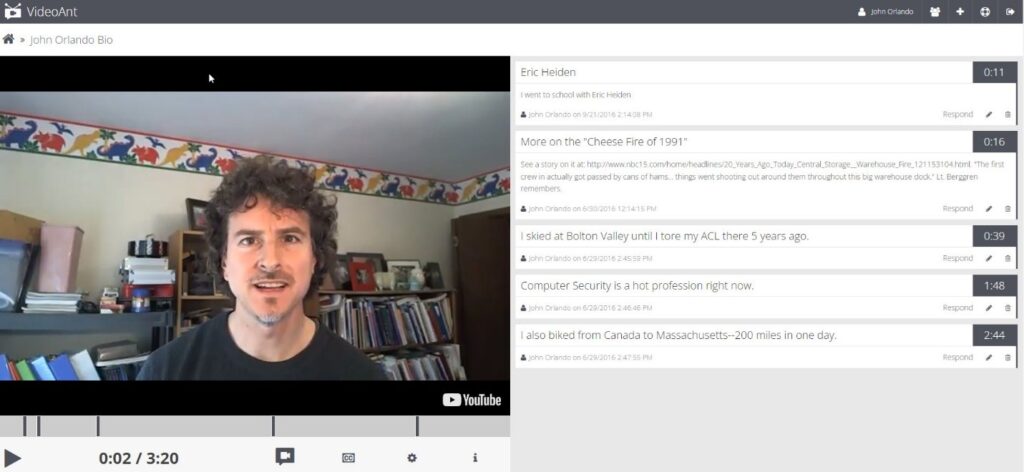It is now well-known that good online courses should make use of the world of free, high-quality educational videos available on nearly any topic. It is also well-known that interaction with lesson content, in which students must think about the lesson material while going through it, is critical to moving the information from student working to long-term memory. But these two practices are still rarely combined. Videos are shown without interactions, making the experience analogous to watching TV.
One way to bridge this gap is with student annotations of course videos. Instructors make notes in the margins of the articles they read to assimilate the information and help them find it later, but they do not provide a way for students to do the same with the videos used in their courses. The best instructors add multiple-choice questions to their videos, which is an excellent start, but it still falls short of the mental engagement of writing down thoughts and questions about the content.
There are a variety of excellent, free systems that allow students to collectively annotate course videos to improve learning for both the students making the annotations and those reading them. These annotations greatly improve the power of videos as an educational tool.
Annotation types
Rather than just setting up a video on an annotation system and tell students to “go after it,” instructors should give students some direction on the types of annotations that are possible as well as post examples of each. These will help jump-start the process and broaden student thinking on how they can view course content reflectively.
Summary
The most straightforward annotation type is a brief summary of the main point of a section, such as “The medical profession has moved from a paternalistic to an autonomy-based view of the doctor-patient relationship.” These summaries can help other students understand the material as well as develop the ability to abstract the central point from a text. Instructors can also encourage students to post alternative summaries when they see a different main point, illuminating what others have missed, or an error in another summary. Now they are thinking about both the video and how others interpret it, giving them a second level of analysis.
Question
Questioning shows an even deeper engagement with the topic than summarization, and ultimately, higher education should teach students to approach content with a questioning mind. But questions come in two forms. One, a student might honestly not understand something and so ask a question like “If the puppets represent the Forms in the Allegory of the Cave, then what does the Sun represent?” Students like answering each other’s honest questions and will quickly jump in with possible answers.
Two, sometimes a question is really an objection that raises a problem with the claims in some content, such as “I don’t understand why Kant assumes that . . .” We should encourage them as much as possible, and they demonstrate deep thinking and can serve as good starting points for further discussion of the concepts.
Comment
A third type of annotation is a simple comment expressing the viewer’s thoughts on the material. Someone might note that a certain point raised in the video corrected a prior misunderstanding, or makes them wonder about some similar topic. Students might also amplify a point they see as important by adding additional information or support for it. Comments might also draw connections with other course topics, helping students connect new information to their broader knowledge base.
Video annotation systems
The learning management system still does not allow instructors to add interactions to videos, and so instructors will generally need to go elsewhere to facilitate student annotations. Here are some good options:
- VideoAnt was the first free system to allow video annotations, and despite not changing much over the years, it is still an excellent tool for instructors interested in a simple method for adding text annotations to videos. The instructor copies a link to the video into VideoAnt and shares the VideoAnt link with students; when students watch it on the site, they can post annotations that appear to the right of the video. Instructors can make the video public or private, create groups with permission to see the video, and even give individual students different levels of access, such as view only or view and annotate.

- Timelinely has a more modern look than VideoAnt. The video window is larger than VideoAnt’s, and a timeline at the bottom shows where people have added annotations to the video, allowing users to scroll forward to view particular annotations. Timelinely also allows users to include images, videos, GIFs, audio, and Google Maps locations in annotations.

- Reclipped is similar to Timelinely in its modern look and ability to host annotations in a variety of forms, but it adds the ability to show shorter clips from longer videos found on a variety of sites, including YouTube, Vimeo, TED, and others, which is helpful when you just want to use part of a video in a course. It also displays all the videos a user has uploaded on an easy-to-search, Pinterest-like board.

There is no reason that an online video used in a course should lack any opportunity for annotations. At the very least, the instructor can use an annotation system to add comments that highlight or amplify important points in a video, thus drawing students to what the instructor wants them to learn. But these initial comments should entice students to add their own annotations that activate thinking about the video’s topics and help students learn to approach material with a thoughtful mindset.






